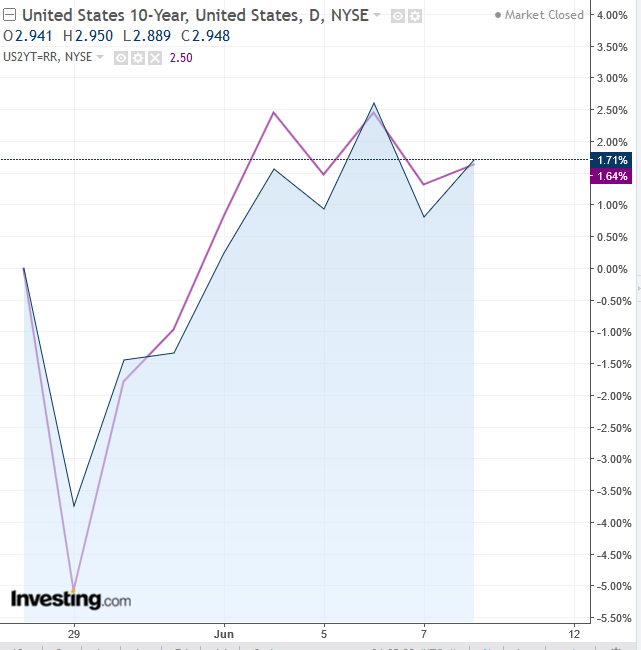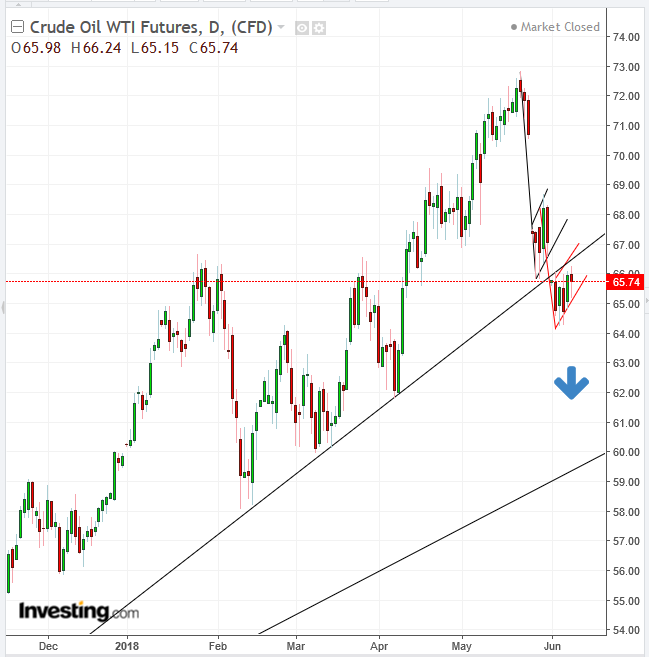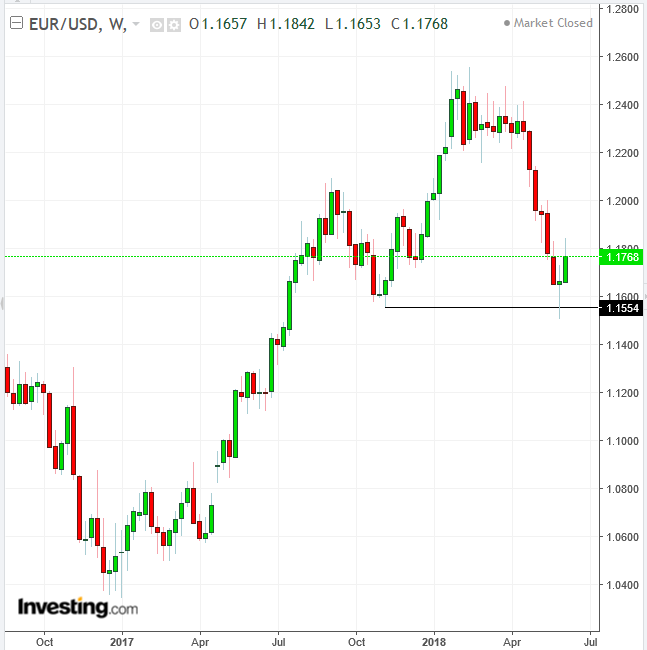- US equities finish both Friday and the week strongly while wiping out trade-war losses, suggesting investors are no longer concerned.
- G7 headlines describe event as disastrous; will traders return to risk-off?
- US yield curve flattens, recession signaled? Investors are more focused on economic fundamentals and geopolitics.
- FOMC and ECB rate decisions on tap
US stocks finished last week on a strong note with most shares ending Friday near their highs for the day. Of the four US major indices, on Friday the S&P 500 closed up 0.31% followed closely by the Dow, up 0.30%; the Russell 2000 gained 0.28% on the day, while the NASDAQ Composite 'trailed,' up just 0.14%.
Clearly, investors once again chose to focus on positive economic data—including a near-50 year low unemployment rate, higher consumer confidence and an expansion of business investment—sweeping aside a slew of risky geopolitical issues, in particular the ongoing global trade dispute being fueled by US President Donald Trump, ahead of what had promised to be a contentious G7 summit that began on Friday in Quebec. Indeed it was already becoming clear before the summit even started that the US president was potentially setting up to be the least popular guest at that party.
Notwithstanding, for the first time during the past two months, since the trade disagreement has become the strongest headwind to equities, the SPX and Dow outperformed the tech heavy NASDAQ Composite and the small cap Russell 2000. This superior performance of large caps may be a sign that investors regard this two month lag period, along with any consolidation that resulted, as enough time to render large caps, with their multi-national business models, as value stocks. In other words, the boost seen in both these benchmarks might just indicate that investors may be over their trade jitters.
Equity Show Of Force; Additional Rallies Ahead?
For the week, the S&P 500 advanced 1.62 percent, led by the Consumer Discretionary sector (+3.17 percent), followed by Materials (+2.98 percent), signaling that the sector, which was at the heart of the trade spat, has moved past the issue.
Friday’s 0.31 percent advance for the benchmark index was led by Consumer Staples (+1.23 percent), which far outperformed all other sectors, by two to three times. Its outstanding demand was not due to a desire by investors for a defensive sector, but rather was motivated by it lagging other sectors, providing a buying opportunity.
The Dow Jones Industrial Average jumped 2.77 percent for the week, posting its best weekly gain since the beginning of March, outperforming among major US indices. The NASDAQ Composite climbed 1.2 percent on the week while the Russell 2000 gained 1.45 percent over the same period.

Another signal that may indicate investors are no longer fearful of trade tariff risks is that both the Dow and the S&P 500 have recouped almost all their losses since mid-March, when trade fears dominated markets. Furthermore, we would argue that, rather than place their faith in ongoing negotiations, investors simply stopped caring about the issue, at least as of last week. To us, that's underscored by the fact that Friday's close was so strong, even though Trump had already vehemently signaled his adversarial position vis a vis the G7 summit.
Therefore, a show of force from equities, despite little investor expectation of a harmonious G7 summit, which would have been conducive for negotiations to end the trade war, signals the likelihood of additional rallies in the week ahead.
On the other hand, we have to wonder: were traders expecting that the summit would turn out as badly as it has, at least according to media headlines including the Wall Street Journal's, Trump Refuses o Back G-7 Statement, Escalating Tensions, and the Guardian's G7 in disarray after Trump rejects communique and attacks ‘weak’ Trudeau, as well as this from Reuters. Trump and his supporters might dismiss it all as 'fake news,' but the US president was very vocal about his position: he called for the elimination of tariffs on goods from G-7 countries aimed at the US and an end to the US being used as the world’s “piggy bank.”
As well, even as US data has been strong, the euro area Composite PMI fell to 54.1 in May from 55.1 in April. All this occurring with the backdrop of fiscal stimulus from US tax cuts, and consensus expectation for a 3.3 GDP release in the second quarter, which, if proven correct, would be the strongest since 2014, and a 3-percent growth for the remainder of the year.
But would a disastrous meeting with trading partners push the trade dispute back into the limelight? Of course, one can never know how investors will actually react to events (as they themselves often don't know). We'd place our bets on heavy volatility as long as the story remains at the forefront of media coverage. At the very least, investors will have had the weekend to settle their nerves, hopefully muting their reaction when markets resume trade on Monday. Of course, should US trading partners increase the anti-tariff rhetoric, it would undo the weekend respite.
Meanwhile, investors may also want to keep an eye on the US-North Korean summit in Singapore, where Trump is headed next, with his characteristic bravado undiminished. This time he's announced that this meeting will be Pyongyang's one and only shot.

An additional risk still lurking in the shadows is the US yield curve. It's flattening, with a roughly 40 basis points between the 2-year and 10-year Treasury yields right now.
Should the short-term versus long-term interplay worsen, it might reverse, with 2-year yields higher than 10-year yields. Statistically, this has proven to be a sign of an upcoming recession. However, investors are currently too focused on ongoing economic data and the trade war headlines.
Week Ahead
All times listed are EDT
Monday
4:30: UK – Trade Balance, Industrial and Manufacturing Production (April): trade deficit forecast to widen to £3.6 billion.
21:30 Australia – NAB Business Confidence (May): index expected to hold at 10.
Tuesday
- US/North Korea Summit: the long-awaited,on-again/off-again/on-again meeting between President Trump and Kim Jong-Un takes place in Singapore.
4:30: UK – Employment data: May Claimant Count to fall to 7800 from 31,200, while the Unemployment Rate in April holds at 4.2%. Average Earnings (including Bonus) to rise to 2.6%, in line with March.
5:00: Germany – ZEW Index (June): economic sentiment to rise to 7.9 from -8.2.
8:30: US – CPI (May): inflation expected to rise 2.6% from 2.5% YoY and 0.2% from 0.2% MoM. Core CPI to rise 0.2% from 0.1% MoM, and rise 2.2% from 2.1% YoY.
20:30: Australia – Westpac Consumer Confidence (June): index expected to rise to 102 from 101.8.
Wednesday
4:30: UK – CPI (May): prices expected to rise 2.5% from 2.4% YoY, and 0.2% from 0.4% MoM.
5:00: Eurozone – Employment (Q1): employment expected to rise 1.8% YoY from 1.6%.
8:30: US – PPI (May): forecast to rise 0.2% from 0.1% MoM.
10:30: US – EIA Crude Inventories (w/e 8 June): stockpiles expected to fall by 1.8 million barrels, after a 2.07 million barrel increase a week earlier. Signs that OPEC members may disagree over production policy next month pushes prices lower.

Oil's supply-demand balance formed a back-to-back continuation falling flag pattern, suggesting that prices would continue to fall. After violating the uptrend line since August 31, the patterns implied they will continue toward the uptrend line since June of last year, toward $60 a barrel.
14:00: US – FOMC Rate Decision: another slight increase in rates is expected, to 2% from 1.75%. The accompanying statement and press conference which follows (at 14:30) will also be key for market direction.
21:30: Australia – Employment Data (May): unemployment rate expected to fall to 5.5% from 5.6%, while 20,000 jobs expected to have been created, from 22,600 a month earlier.
22:00: China – Retail Sales (May): sales expected to rise 9.5% from 9.4%.
Thursday
4:30: UK – Retail Sales (May): forecast to rise 1.8% from 1.4% YoY, and 0.2% from 1.6% MoM.
7:45: Eurozone – ECB Rate Decision (followed by Press Conference at 8:30): while no change in interest rates is expected, the recent comments from the ECB’s chief economist mean that a potential end-date for QE may be discussed. There is a dispute among analysts whether central banks other than the Fed may, in fact, begin to tighten.

While the euro climbed for two straight weeks, its pattern opens up the possibility for an H&S top reversal. A downside breakout of the neckline would support dollar bulls, who claim that other central banks cannot compete with the Fed. After the superior performance mid-last year of the eurozone economy, the dollar bull argument becomes stronger considering that US growth has now been outpacing that of the EU economy.
8:30: US – Retail Sales (May), Initial Jobless Claims (w/e 9 June): retail sales expected to rise 0.4% from 0.2% MoM, and 4.4% from 4.6% YoY. Initial jobless claims to rise by 223K from 222K a week earlier.
23:00: Japan – BoJ Rate Decision: no change expected.
Friday
8:30: US – Empire State Manufacturing Index (June): index forecast to fall to 20 from 20.1.
10:00: US – Michigan Consumer Confidence (June, preliminary): forecast to rise to 99 from 98.
